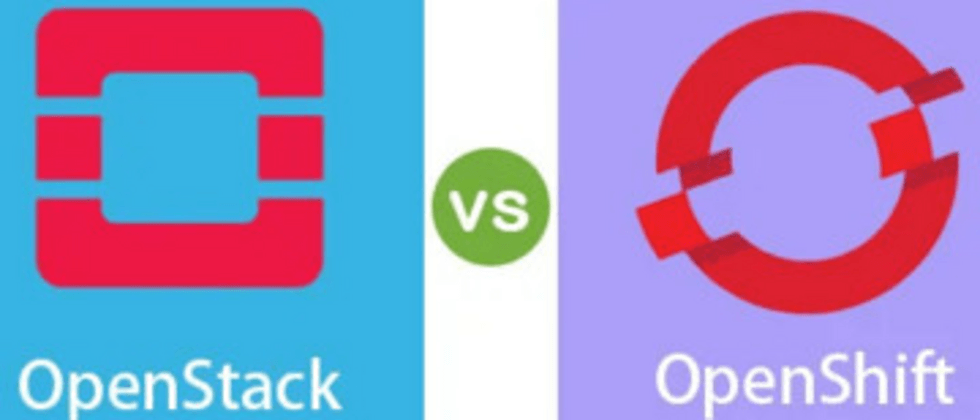Both OpenShift and OpenStack were created around 2010, 2011 as open source technologies for building scalable cloud platforms, and both are used to build scalable systems in hybrid cloud environments. Historically, OpenStack has been around longer than OpenShift. The evolution of these two projects represents a shift from virtual machines to application containers.
OpenShift is a Paas (Platform as a Service) model that runs primarily on top of existing cloud services such as AWS, Google Cloud Platform, and is used to develop and operate containerized applications. Users can provision, operate, and monitor applications and services themselves, and focus on optimizing development and DevOps workflows. While OpenStack has a deeper abstraction, OpenStack is an Iaas (Infrastructure as a Service) that can be used to convert existing servers into cloud services. The platform is used to build virtualized cloud infrastructures based on distributed hardware, provisioning virtual machines with CPU cores and RAM, as well as virtual networks and distributed storage.
At a time when container virtualization technology has become the dominant virtualization technology, because the two technologies, OpenShift and OpenStack, are non-interfering and independent of each other, they are usually used in combination. For example, OpenShift can be built on OpenStack, the server infrastructure is built by OpenStack, and OpenShift exists as a third-party API service. Can also be used simultaneously in a single application. OpenShift can also be deployed directly in cloud services built on the OpenStack platform.
The combination of OpenShift and OpenStack can completely cover from configuring virtualized hardware to developing and operating containerized applications, which can effectively reduce customers' setup costs, improve the efficiency and productivity of existing workflows, and ensure application scalability. As a result, OpenShift and OpenStack are widely used to implement hybrid cloud strategies and are popular with large global organizations.
Let's take a detailed look at the advantages and disadvantages of these two technologies, as well as common deployment scenarios.
OpenStack
OpenStack is an open platform for building scalable cloud environments. Its core function is to provide and distribute computing, networking and mass storage. In addition to the API, there is a web interface for managing the system.
In addition to resource provisioning, OpenStack provides other functions including user identity management, DNS entry management, and services for managing VM images. More conveniently, individual functions are encapsulated as individual components. Of course, not all components must be deployed when in use. Below we briefly introduce some of the more commonly used components:
OpenStack is suitable for building cloud infrastructure on distributed computing hardware. Combined with OpenShift or a similar K8s management solution, VMs and container-based applications can run in parallel. Container virtualization, with its "Magnum" component, forms part of its native range of capabilities.
OpenStack pros and cons
OpenStack can help enterprises build their own cloud infrastructure based on existing technologies, which can save a lot of costs. At the same time, because of the characteristics of individual components, companies can flexibly configure them according to their needs. These are the reasons why people choose OpenStack, and of course the most important thing is that OpenStack is free and open source software.
However, OpenStack also has some disadvantages, most notably because of the complexity of the software, which consists of a large number of individual components that must be configured individually. This makes installing OpenStack extremely challenging. At the same time, because the documents contributed by the community may not keep up with the rapid development of technology, the update iteration will be slower. Of course, engineers can solve problems by working with experts or technology partners. However, such services may incur additional charges.
OpenShift
OpenShift is used to build distributed, scalable applications and development environments. The software provides a complete execution environment in which containers can be deployed, executed, managed and orchestrated. Integrated tools simplify modern development and deployment workflows. OpenShift is typically used as a platform-as-a-service (PaaS), software-as-a-service (SaaS), and container-as-a-service (CaaS) solution for enterprises. But OpenShift is skewed towards large enterprise organizations and can be too complex for a single developer.
OpenShift uses a special K8S distribution that can be deployed across cloud and infrastructure boundaries with the same user experience. The core functionality of K8S is complemented by security and monitoring functions and is managed based on centralized policies. Among them, Operator is a way to package, deploy and manage K8S native applications. K8S native applications are applications that are both deployed on K8S and managed using the K8S API and kubectl tools. Typically, Operators in OpenShift are used to implement:
OpenShift pros and cons
One of the biggest advantages of using OpenShift is the ability to run software in a hybrid cloud environment, which also speeds up development workflows and greatly reduces development time. Another aspect is high security. Preventing cyber intrusions and data breaches is critical for companies. End-to-end authorization and authentication restricts user access to different areas of the system, contributing to better data protection.
Of course, OpenShift also has some drawbacks. It only supports running on special operating systems from Red Hat, such as Red Hat Enterprise Linux CoreOS (RHCOS) and Red Hat Enterprise Linux (RHEL). Installation is also relatively complicated. Due to strict security settings, not all Docker Hub containers can be used under OpenShift.
As two important means to help enterprises complete virtualization, OpenShift and OpenStack are widely used by major enterprises. It is also something that developers will inevitably encounter when developing systems and platforms. I hope this article can help you understand both.
Recommended reading
A wise helper in the self-media era - AI video cloud
How does handle large XLSX/CSV/TXT files?






**粗体** _斜体_ [链接](http://example.com) `代码` - 列表 > 引用。你还可以使用@来通知其他用户。